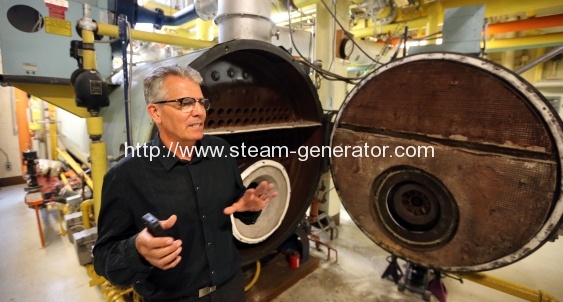End of the steam age nigh for legislature heating
Michael
Masson, environmental lead at the Technology Ministry, says that while
the steam boiler system is working, “It is older technology and we are
looking to see what else can potentially be done.” Alternate energy
supplies and methods to reduce greenhouse gases are on the wish list.
Photograph By
ADRIAN LAM, Times Colonist
Old
steam boilers heating the legislature and nearby buildings were once on
the leading edge of technology, setting the standard for systems
adopted throughout the province.
Today, the facility is getting tired and the province is seeking ideas to replace and possibly expand it.
Tucked into its own building behind the Douglas building at 617
Government St., the 1952 plant was originally powered by coal. Chains
that used to carry coal-filled totes still hang inside.
The plant was later converted to run on bunker fuel and these days, runs on natural gas, using 34,000 gigajoules per year.
A network of pipes carrying steam runs underground to the legislature,
where radiators are still used, as well as to the Queen’s Printers and
other buildings on Superior Street, and to the Douglas building.
Together, the four boilers have the capacity to generate 16.64 megawatts per hour. A megawatt is equal to one million watts.
The aim now is to find out if there’s private-sector interest in
designing, building, financing and operating an energy system for that
area of the city.
The Ministry of Technology, Innovation and Citizens’ Services and the
Royal B.C. Museum have issued a request for expressions of interest,
closing Sept. 19. Alternate energy supplies and methods to reduce
greenhouse gases are on the wish list.
Michael Masson, environmental lead at the Technology Ministry, said
Tuesday that while the system is working, “It is older technology and we
are looking to see what else can potentially be done. There are ongoing
repair costs.”
No timeline is in place at this early stage, he said.
A new system may feed the Royal B.C. Museum and the six-acre South
Block in the 500 blocks of Superior and Michigan streets, which is being
developed for residential, office and commercial uses, the request
said. It’s up to the new private-sector owners of the South Block to
decide whether to participate.
The plant is in the midst of its annual shutdown, when it’s refurbished, said Bob Hope, the plant’s chief engineer.
The boilers used to run continuously, but a “hugely successful”
energy-conservation system was introduced in the early 1980s by the B.C.
Buildings Corp., he said. Daily shutdowns and start-ups were introduced
using computerized systems.
Computers examine variables that decide the best time to start the
plant, even though a lot of the control remains with operators on site,
Hope said.
“It made a huge impact on the footprint of the operation of the plant,”
he said, adding that the system was introduced to government buildings
throughout B.C. “It’s all about saving energy for the province.”
Heating season typically begins in October, when the temperature drops.
“We start the boilers up every night and we shut the boilers down every
afternoon,” Hope said.
The plant is closed on weekends, until colder weather arrives in
December, January and sometimes February, when the plant runs around the
clock.


